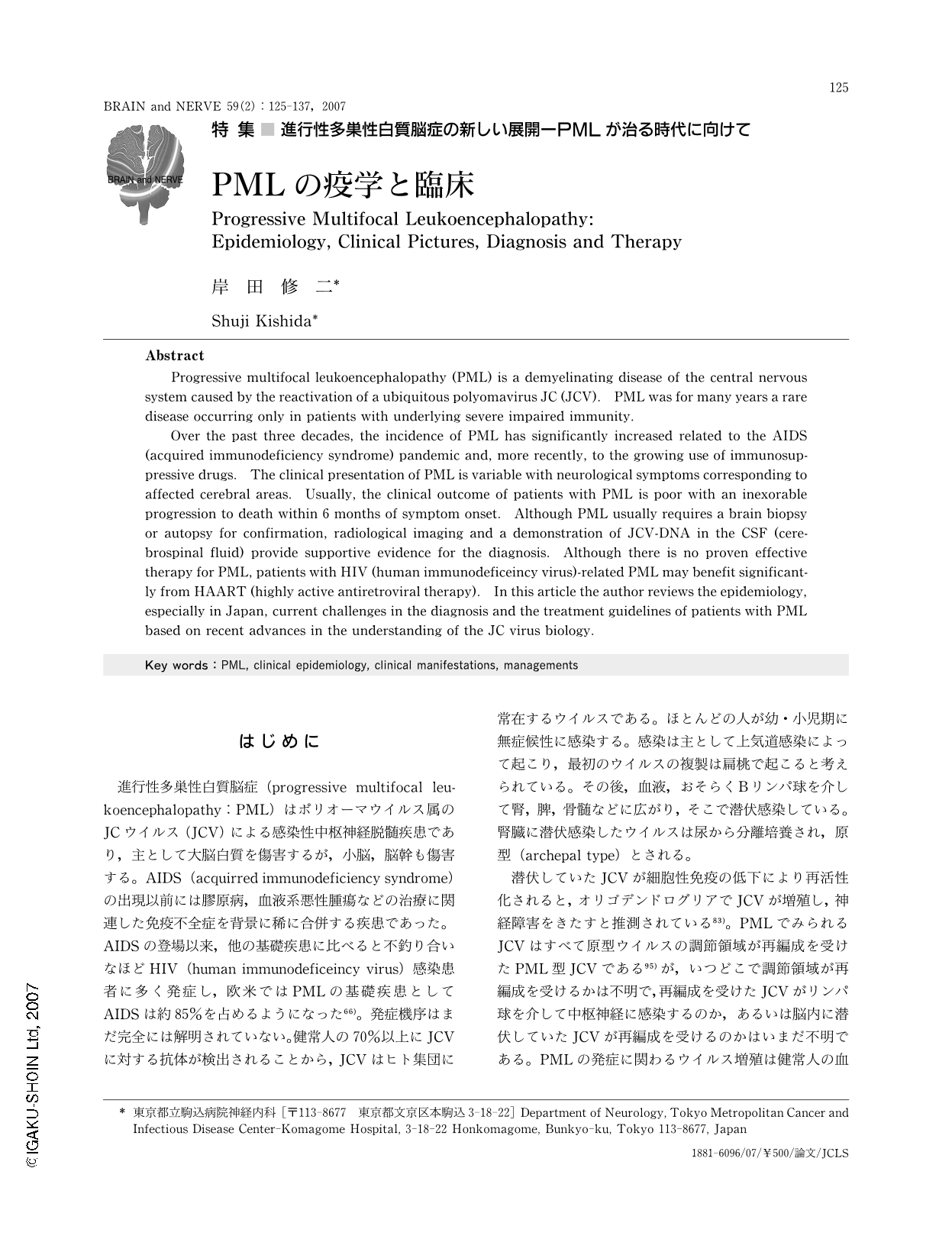Japanese
English
- 有料閲覧
- Abstract 文献概要
- 1ページ目 Look Inside
- 参考文献 Reference
はじめに
進行性多巣性白質脳症(progressive multifocal leukoencephalopathy:PML)はポリオーマウイルス属のJCウイルス(JCV)による感染性中枢神経脱髄疾患であり,主として大脳白質を傷害するが,小脳,脳幹も傷害する。AIDS(acquirred immunodeficiency syndrome)の出現以前には膠原病,血液系悪性腫瘍などの治療に関連した免疫不全症を背景に稀に合併する疾患であった。AIDSの登場以来,他の基礎疾患に比べると不釣り合いなほどHIV(human immunodeficeincy virus)感染患者に多く発症し,欧米ではPMLの基礎疾患としてAIDSは約85%を占めるようになった66)。発症機序はまだ完全には解明されていない。健常人の70%以上にJCVに対する抗体が検出されることから,JCVはヒト集団に常在するウイルスである。ほとんどの人が幼・小児期に無症候性に感染する。感染は主として上気道感染によって起こり,最初のウイルスの複製は扁桃で起こると考えられている。その後,血液,おそらくBリンパ球を介して腎,脾,骨髄などに広がり,そこで潜伏感染している。腎臓に潜伏感染したウイルスは尿から分離培養され,原型(archepal type)とされる。
潜伏していたJCVが細胞性免疫の低下により再活性化されると,オリゴデンドログリアでJCVが増殖し,神経障害をきたすと推測されている83)。PMLでみられるJCVはすべて原型ウイルスの調節領域が再編成を受けたPML型JCVである95)が,いつどこで調節領域が再編成を受けるかは不明で,再編成を受けたJCVがリンパ球を介して中枢神経に感染するのか,あるいは脳内に潜伏していたJCVが再編成を受けるのかはいまだ不明である。PMLの発症に関わるウイルス増殖は健常人の血中にJCV特異的細胞障害性Tリンパ球が存在していること33-35,60),HIV感染患者に多発すること,T細胞の組織浸潤を阻止する抗インテグリンα4モノクローナル抗体(natalizumab)を投与中の多発性硬化症,クローン病患者に発症したこと58,62,63,90)などから,液性免疫よりも細胞性免疫がより強く制御していると考えられる。
ところで,わが国では免疫不全症を合併する治療法やAIDSなどの疾患が増加しているものの,統一した診断基準をもとにした疫学調査はこれまでなかった。そこでPMLに対し2004年診断基準を作成し(臨床診断の項に記載),神経内科専門医を対象に,1999~2003年度の疫学調査55)を行い,さらに2005年詳細な臨床像を得るために第二次調査57)を行ったので,その結果を踏まえながら述べる。
Abstract
Progressive multifocal leukoencephalopathy (PML) is a demyelinating disease of the central nervous system caused by the reactivation of a ubiquitous polyomavirus JC (JCV). PML was for many years a rare disease occurring only in patients with underlying severe impaired immunity.
Over the past three decades, the incidence of PML has significantly increased related to the AIDS (acquired immunodeficiency syndrome) pandemic and, more recently, to the growing use of immunosuppressive drugs. The clinical presentation of PML is variable with neurological symptoms corresponding to affected cerebral areas. Usually, the clinical outcome of patients with PML is poor with an inexorable progression to death within 6 months of symptom onset. Although PML usually requires a brain biopsy or autopsy for confirmation, radiological imaging and a demonstration of JCV-DNA in the CSF (cerebrospinal fluid) provide supportive evidence for the diagnosis. Although there is no proven effective therapy for PML, patients with HIV (human immunodeficeincy virus)-related PML may benefit significantly from HAART (highly active antiretroviral therapy). In this article the author reviews the epidemiology, especially in Japan, current challenges in the diagnosis and the treatment guidelines of patients with PML based on recent advances in the understanding of the JC virus biology.

Copyright © 2007, Igaku-Shoin Ltd. All rights reserved.


